 |
August 2015
|
August 2015 // Volume 53 // Number 4 // Tools of the Trade // v53-4tt8
Weed Garden: An Effective Tool for Extension Education
Abstract
A weed garden was constructed to quantify and improve identification skills among clientele. The garden was planted with over 100 weed species based on surveys on problematic weeds. The weed garden proved useful for introducing additional hands-on learning activities into traditional lecture-based seminars. Through seminar and field day attendee feedback, data were gathered on weeds commonly misidentified. The data reflected the need to continue focusing education efforts on weed identification and to increase training on weeds commonly misidentified. Through continued use of the weed garden, Extension specialists can enhance clientele identification skills and aid in developing effective weed management strategies.
Introduction
For Extension educators, educational programming should include delivery methods that help clients gain not only knowledge, but also experience through exploration. As such, enhancement of delivery to increase educational effectiveness should be a priority (Richardson, 1994; Comer, Birkenholz, & Stewart, 2004). Among turfgrass Extension specialists, the use of workshops and seminars to inform and educate clientele is common; however, hands-on demonstrations have also been observed to enhance learning and direct thought shifts and practices of attendees (Harmon & Jones, 1997; Patton, Trenholm, & Waltz, 2013). In recent years, Extension agents and specialists across the country have developed gardens to educate clientele about multiple issues (Glen, Moore, Jayaratne, & Bradley, 2013 & 2014).
When combined with traditional education programming, visits to hands-on demonstration sites increase learning and influence management decisions (Richardson, 1994; Harmon & Jones, 1997; Hamilton & DeMarrais, 2001). The proper identification of weeds and their life cycle is essential to developing effective weed management strategies (LeStrange & Reynolds, 2004). A weed garden was constructed to improve weed identification skills of clientele and to increase the use of hands-on educational demonstrations. The weed garden was then featured at turfgrass science-based Extension seminars and field days through Purdue University and the Midwest Regional Turf Foundation (MRTF).
Objectives
The primary objective of the weed garden was to provide basic weed identification education for turf and landscape clientele. This article describes how the weed garden was designed. Secondary objectives, through educational programing, were to gather data on weeds that are difficult to control in managed turf and to justify the need for additional weed identification education.
Weed Garden Construction
A garden was constructed at the W.H. Daniel Turfgrass Research and Diagnostic Center in West Lafayette, Indiana in the fall of 2013 (Figure 1). It was designed to contain pots for 120 weeds commonly found in turf and landscapes in the Midwest.
Figure 1.
Purdue University Turfgrass Extension Weed Garden (2014)

The garden was a pot-in-pot design similar to that used in nurseries. A hole was dug 8 inches deep and 15 inches in diameter to house the bottom pot. A second pot was then stacked into the first after placing two shallow bricks in between the two pots to prevent them from wedging together and to allow for easy mobility should the pots need to be moved and/or reorganized. All pots were #6 short black polycan pots (Anderson Die & Manufacturing Inc., Portland, OR). The centers of each pot were placed 3 feet apart from each other, and every pot measured 13.75 x 9.75 inches with a 5-gallon capacity. Two rows consisting of 20 pots each (40 pots total) were paired together. An additional two sets of rows (20 pots x 6 rows = 120 pots) were placed 6 feet apart to create alleyways for observers (Figure 2). Weeds were collected locally and transplanted into pots. Pots were hand-irrigated daily on newly transplanted weeds, then as needed to maintain healthy plants. Hardwood mulch was placed throughout the weed garden to improve aesthetics and designate an appropriate walkway (Figures 2 and 3). Many perennial weeds survived the first winter, while some needed recollecting. Many annual weeds, reestablished from seed within the pot.
Figure 2.
Pot-in-Pot Designed Weed Garden with 6-Foot Alleyways for Easy Access for Attendees
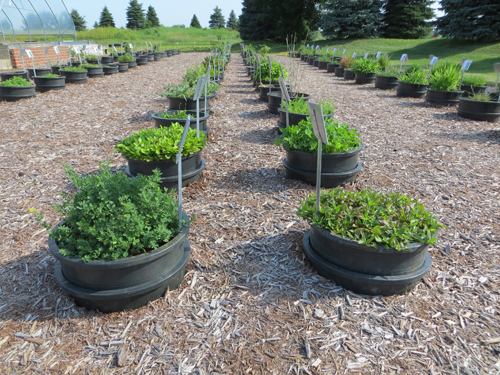
Figure 3.
Attendees Using the Weed Garden During the Purdue Turf and Landscape Field Day
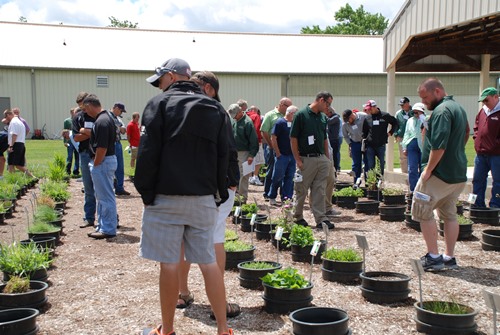
Educational signs were designed for each weed to include pictures, scientific name, life cycle, germination period, key identifying characteristics, and a list of one or two similar weeds (Figure 4). Signs were laminated to make them more durable and placed into aluminum sign holders (Hummert International, Earth City, MO).
Figure 4.
Each Weed Was Paired with a Sign that Included Information to Aid in Proper Weed Identification
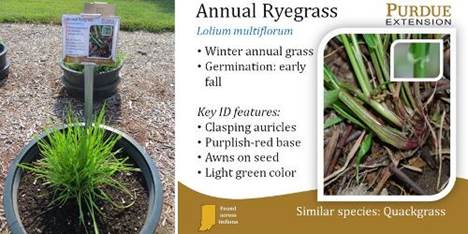
Attendee Surveys
Weeds were included in the weed garden based on survey feedback from herbicide workshops conducted by the MRTF in Indiana and Illinois (Figures 5 & 6, Table 1). Seminar attendees reported weeds that occurred most often in the turf they managed as well as weeds they had the greatest difficulty controlling. From survey data representing 12 locations and 588 respondents, we were able to ascertain which weeds to include in the weed garden and to focus research efforts. The data reflect that attendees most commonly encounter dandelion (86%) and crabgrass (83%)(Figure 5). The data also reflect that the most difficult to control weeds were ground ivy, wild violet, and yellow nutsedge (Figure 6). Other difficult to control weeds were identified by participants as less common (Table 1), but were included in the weed garden.
Figure 5.
Ranking of the Most Commonly Observed Weeds by Midwest Turf Managers
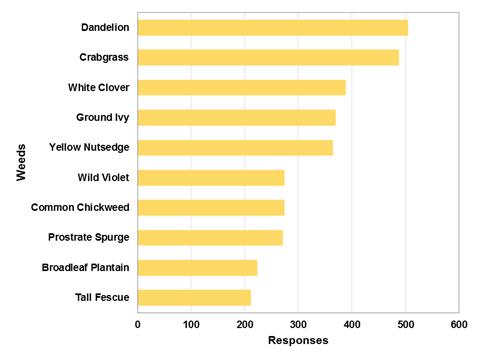
Figure 6.
Top-20 Most Difficult to Control Weeds Selected by Midwest Turf Managers

| Weed | Number of Respondents |
| Paspalum spp. | 10 |
| Fountain Grass, Buckhorn Plantain | 9 |
| Marestail | 8 |
| Common Plantain, Lespedeza | 7 |
| Horsetail, Lesser Celandine | 6 |
| Black Medic, Yellow Woodsorrel | 5 |
| Birdsfoot Trefoil, Johnsongrass | 4 |
| Field Bindweed, Windmillgrass, Yarrow | 3 |
| Bittercress, Bull Thistle, Common Groundsel, Indian Mock-Strawberry, Mouse-Ear Chickweed, Purple Deadnettle, Speedwells, Virginia Buttonweed, Yellow Foxtail | 2 |
| Annual Kyllinga, Annual Ryegrass, Barnyardgrass, Carolina Geranium, Common Mallow, Common Ragweed, Common Reed, Crown Vetch, Garlic Mustard, Horsenettle, Kochia Milkweed, Moss, Purple Nutsedge, Reed Canarygrass, Rough Bluegrass, Star-of-Bethlehem, Zoysiagrass | 1 |
Identification Skills
To ascertain the identification ability of clientele, attendees for the 2014 MRTF Lawn Diagnostic Training Seminar were quizzed on their ability to correctly identify live weed samples that reflect commonly occurring turf weeds in Indiana. A quiz consisting of 10 "easy-difficulty-to-identify" weeds and 10 "medium-difficulty-to-identify" weeds was given to 43 seminar attendees.
The quiz scores reflected a definite need to continue focusing education efforts on weed identification. Attendees were able to correctly identify an average of 48% of the "easy" weeds (Figure 7). The weeds most consistently identified correctly included dandelion, Canada thistle, and yellow nutsedge (91, 79, and 79%), while the weeds that were least correctly identified included prostrate knotweed, annual bluegrass, and goosegrass, with only 7, 26, and 30% of correct responses, respectfully (Figure 7). Quiz results also determined that the attendees were able to correctly identify an average of only 13% of the "medium" weeds (Figure 8). Weeds most consistently identified correctly included wild carrot (37%) and mouse-ear chickweed (26%), while lespedeza and common mallow were least correctly identified (0 and 2%), respectively (Figure 8). Additionally, 86% of the incorrect responses miss-identified common mallow as ground ivy. The correct identification of weeds is essential to the development of an effective weed management program. Many difficult to identify weeds are often also difficult to control (Patton & Weisenberger, 2015). Thus education efforts should include special attention on identification and control options for weeds most commonly misidentified.
Figure 7.
Success of Workshop Attendees in Identifying "Easy-Difficulty-to-Identify" Turf Weeds

Figure 8.
Success of Workshop Attendees in Identifying "Medium-Difficulty-to-Identify" Turf Weeds
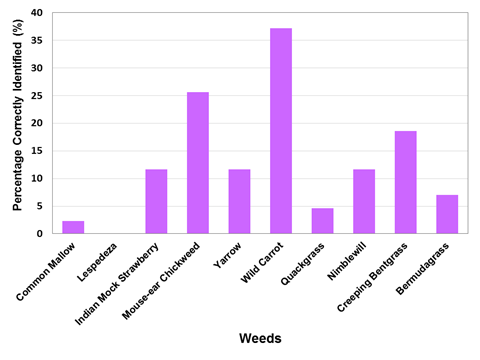
Conclusion
A weed garden offers a valuable tool for improved hands-on Extension education. A weed garden also provides quick feedback on specific weeds that clientele have difficulty identifying. Seminar and field day attendees have all provided positive feedback on the helpfulness of the weed garden, although we have yet to measure changes in identification skills of specific attendees over time.
Acknowledgements
The authors want to express their gratitude to the Midwest Regional Turf Foundation for sponsoring seminars and for funding the construction of the weed garden. Additionally, we want to thank Dan Weisenberger, Glenn Hardebeck, and Geoff Schortgen for compiling survey responses and their assistance during the design and construction of the weed garden.
References
Comer, M. M., Birkenholz, R. J., & Stewart, B. R. (2004). The role of the Cooperative Extension Service as perceived by North Carolina Cooperative Extension Service administrators. Journal of Southern Agricultural Education Research, 54(1). Retrieved from: http://www.jsaer.org/pdf/Vol54/54-01-156.pdf
Glen, C. D., Moore, G. E., Jayaratne, K. S. U., & Bradley, L. K. (2013). Characteristics of Extension demonstration gardens. Journal of Extension [On-line], 51(2) Article 2RIB8. Available at: http://joe.org/joe/2013april/rb8.php
Glen, C. D., Moore, G. E., Jayaratne, K. S. U., & Bradley, L. K. (2014). Use of demonstration gardens in Extension: Challenges and benefits. Journal of Extension [On-line], 51(4) Article 4FEA6. Available at: http://joe.org/joe/2014august/a6.php
Hamilton, S. L., & DeMarrais, K. (2001). Visits to public gardens: their meaning for avid gardeners. HortTechnology 11(2):209-215.
LeStrange, M., & Reynolds, C .A. (2004). Weed management in lawns. University of California Extension. 74113. Retrieved from: http://www.ipm.ucdavis.edu/PMG/PESTNOTES/pn74113.html
Patton, A. J., Trenholm, L., & Waltz, F. C. (2013). Turfgrass Extension and outreach programming. p. 147-177. In J.C. Stier, B.P. Horgan and S.A. Bonos (ed.) Agronomy Monograph 56. Turfgrass: Biology, Use, and Management, American Society of Agronomy, Crop Science Society of America, Soil Science Society of America, Madison, WI.
Patton, A. J., & Weisenberger, D. V. (2015). Turfgrass weed control for professionals. Purdue University Extension Publication. AY-336.
Richardson, J. G. (1994). Learning best through experience. Journal of Extension [On-line], 32(2) Article 2FEA6. Available at: http://joe.org/joe/1994august/a6.php




